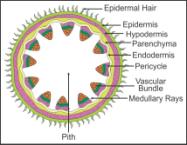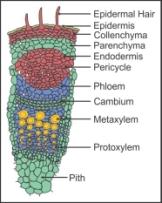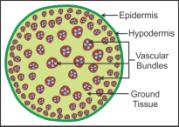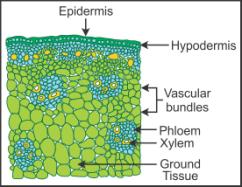Class 11-science NCERT Solutions Biology Chapter 6 - Anatomy of Flowering Plants
Anatomy of Flowering Plants Exercise 78
Solution 1
(a)Monocot root:
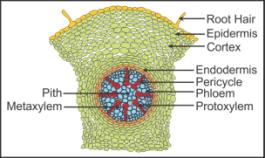
Dicot root:
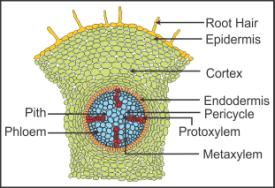
(b)Monocot stem:

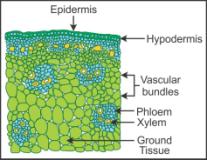
Dicot stem:
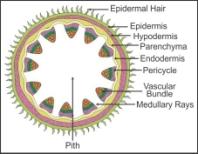
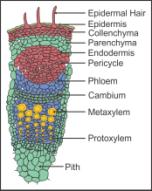
Solution 2
|
Dicot stem |
Monocot stem |
|
i. If the vascular bundles are scattered, then it is a monocot stem. ii. In a monocot stem, the vascular bundles are closed and have a bundle sheath.
|
Solution 3
It is the transverse section of a monocot stem as the vascular bundles are scattered in monocot stems and the phloem parenchyma remains absent in it.
Solution 4
Stomata are structures present in the epidermis of leaves. Stomata regulate the process of transpiration and gaseous exchange. Each stoma is composed of two bean-shaped cells known as guard cells. In grasses, the guard cells are dumbbell-shaped. The outer walls of guard cells (away from the stomatal pore) are thin and the inner walls (towards the stomatal pore) are highly thickened. The guard cells possess chloroplasts and regulate the opening and closing of stomata.
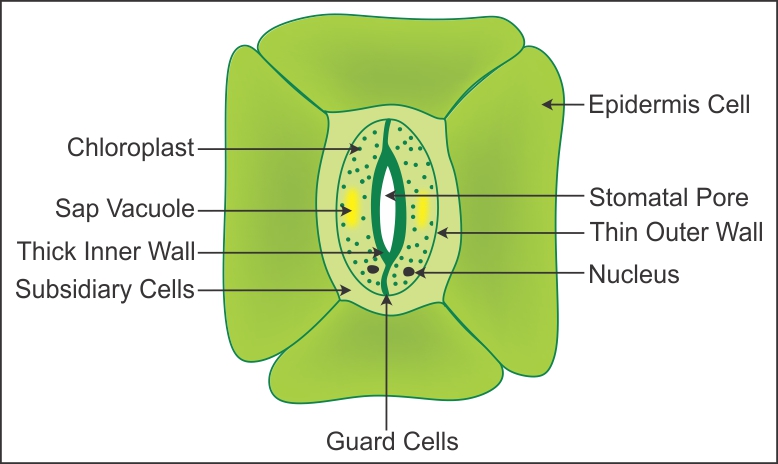
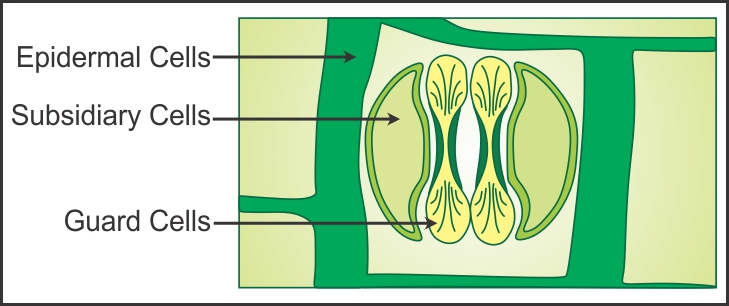
Sometimes, a few epidermal cells near the guard cells become specialised in their shape and size and are known as subsidiary cells. The stomatal aperture, guard cells and surrounding subsidiary cells are together called the stomatal apparatus.
Solution 5
On the basis of their structure and location, there are three types of tissue
systems:
i. Epidermal tissue system: It includes the epidermis and epidermal appendages. The epidermis consists of epidermal cells and guard cells. Epidermal appendages include root hair, stem hair, stinging hair and glandular hair.
ii. Ground or fundamental tissue system: It includes parenchyma, sclerenchyma and collenchyma. The cortex, pericycle, pith and medullary rays usually contain parenchymatous cells.
iii. Vascular or conducting tissue system: It consists of vascular bundles which include phloem, xylem and vascular cambium.
Solution 6
The study of plant anatomy is useful in many ways:
i. To help us understand the way a plant functions by carrying out its routine activities such as transpiration, photosynthesis and growth and repair.
ii. To help botanists and agriculture scientists to understand the disease and cure for plants.
iii. To help in solving various problems related to taxonomy, phylogeny, food adulteration, archaeology and manufacture of various wood products.
iv. Plants are important to maintain the ecological balance of the earth, so understanding plant anatomy is a way to understand the larger system of the ecology on this planet.
Solution 7
Dorsiventral (dicotyledonous) leaf:
The vertical section of a dorsiventral leaf through the lamina shows three main parts-epidermis, mesophyll and vascular system.
i. Epidermis: The epidermis has two parts:
i. Upper or adaxial epidermis: It consists of a single layer of tightly packed rectangular parenchymatous cells which are devoid of chloroplasts. The inner walls of the epidermal cells are thin, whereas the outer walls are cutinised.
ii. The lower or abaxial epidermis bounds the leaf on the lower surface and bears stomata.
ii. Mesophyll: The tissue between the upper and the lower epidermis is called the mesophyll. The mesophyll possesses chloroplasts and carries out photosynthesis. It has two types of cells-palisade parenchyma and spongy parenchyma. The adaxially placed palisade parenchyma is made up of elongated cells which are arranged vertically and parallel to each other. The oval or round and loosely arranged spongy parenchyma is situated below the palisade cells and extends to the lower epidermis.
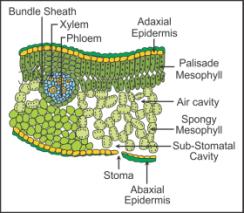
There are numerous large spaces and air cavities between these cells.
iii. Vascular system: It is made up of a number of vascular bundles of varying sizes depending on the venation. The vascular bundles are found at the boundary between the palisade and the spongy regions. Each vascular bundle is surrounded by a sheath of compactly arranged parenchyma cells called the bundle sheath. The xylem lies towards the upper side of the leaf, while the phloem is found towards the lower surface.

